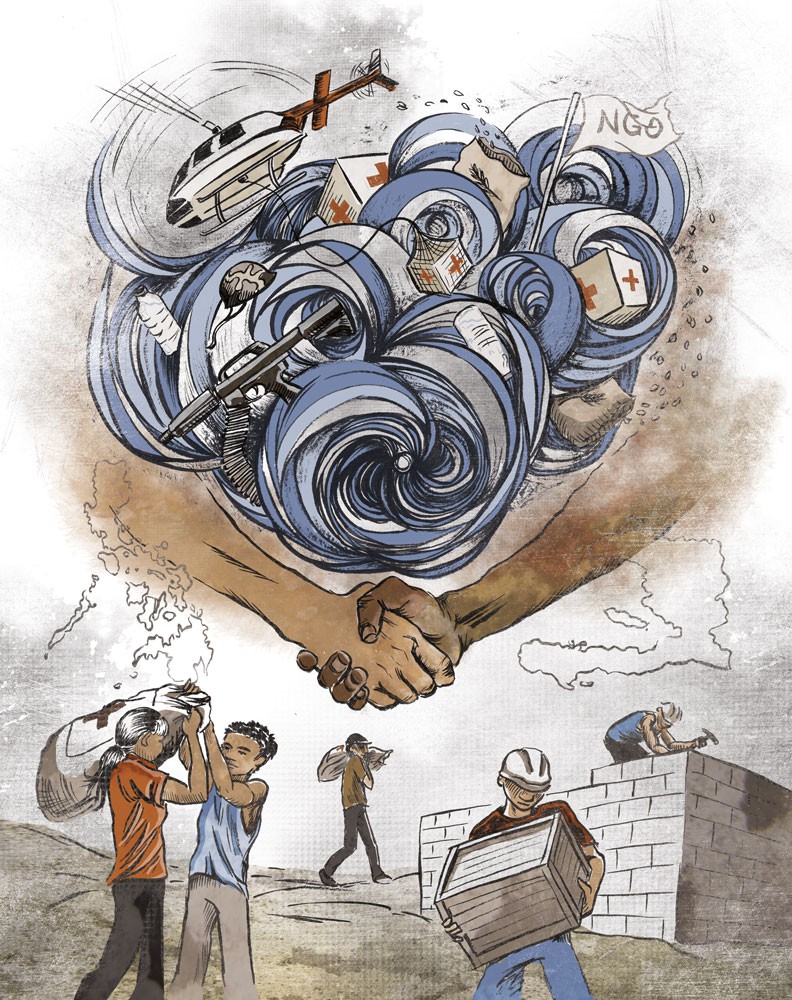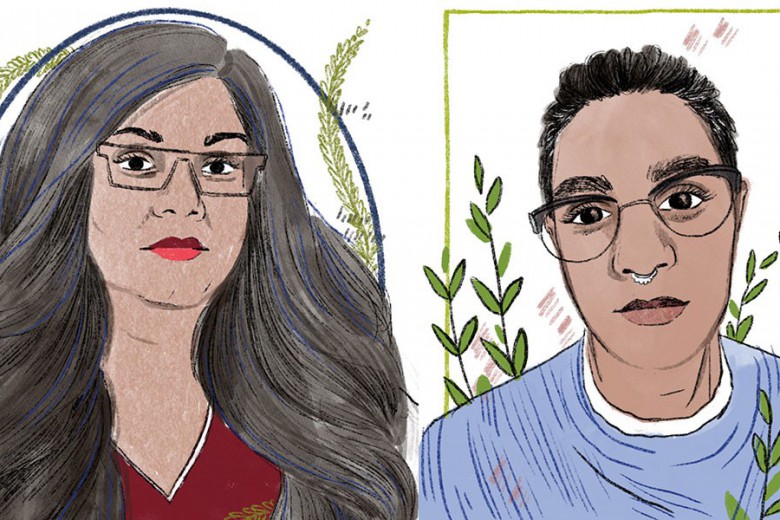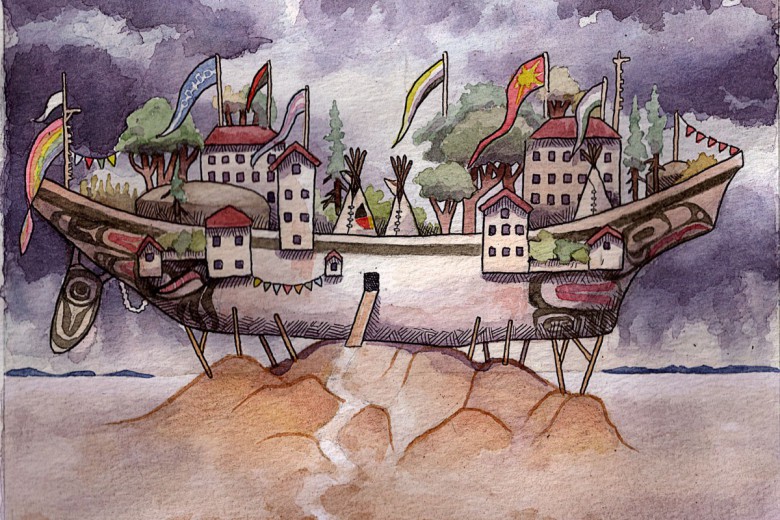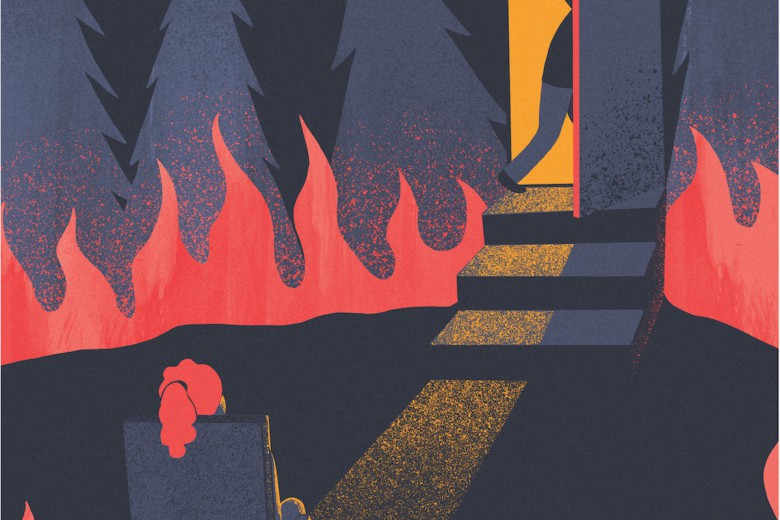
When typhoon Haiyan hit the Philippines last fall, Sandra Borgueta could do little but sit in front of her computer and watch. At school in Seoul, South Korea, Borgueta was well out of harm’s way, but her family was not. As the Category 5 storm made landfall on November 8, 2013, her hometown of Tacloban was battered by winds that reached speeds over 300 kilometres per hour. The storm surge raised the sea by nearly four metres, and the city, the capital of Leyte province, was submerged one kilometre inland.
No typhoon on record has ever made landfall with greater intensity than Haiyan. An estimated 13 million people were affected by the storm, known as typhoon Yolanda in the Philippines, and up to 10,000 people were initially feared dead. The official death toll currently sits at 6,268. Four million people were displaced from their homes and 2.5 million people were in need of food aid following the disaster.
Like Borgueta, I watched from a distance as CNN showed images of waves crashing violently against the shore and then, in the morning light, revealed the destruction left behind. But unlike Borgueta, I watched from a hotel bar in Haiti, a country that is all too familiar with natural disasters and the relief efforts that follow them.
A warning about aid
For many Haitians, the images being broadcast from the southeast Asian country were recognizable. Less than four years earlier, Haiti had been struck by a 7.0 magnitude earthquake. The tremor levelled towns and cities, including the capital of Port-au-Prince, and death toll estimates were as high as 316,000.
“When we heard about what had happened to the Philippines, we immediately had flashbacks to our experience in the earthquake and the numerous hurricanes that have hit Haiti as well,” says Louino Robillard. But it wasn’t just the downed buildings or the ruined streets that seemed familiar to the Port-au-Prince resident. The 27-year-old, who grew up in Port-au-Prince’s notoriously violent neighbourhood of Cité Soleil, also worried about what would befall the Philippines after the storm clouds cleared. “For the first 10 minutes, I hoped that there would be lots of aid for the Philippines. But then I thought about how we needed to warn people about what that aid looked like for us.”
Robillard called this solidarity. Others might label it a reclamation of humanity. While Haiti received a tremendous amount of aid after the January 2010 earthquake, the pèp la, the people, had little control over how it was implemented. They were excluded from the reconstruction process while foreigners wielded control. As a result, Haitians have organized and offered their solidarity to the people of the Philippines in order to prevent the same thing from happening there.
To feel human
I first met Robi, as Robillard is known, just down the road from the Toussaint Louverture International Airport in a compound belonging to the non-governmental organization Haiti Communitere. In a sweltering room, nearly two dozen Haitians and foreign development workers were meeting to discuss the typhoon that had just struck the Philippines. Over the din of the small, overworked air-conditioning unit, the group was discussing what they could do to aid those impacted by the super typhoon.
“What’s important is that the people in the Philippines continue to feel human,” noted Robillard. “It didn’t feel that way for us after the earthquake.”
He later elaborated. “In the first few days after the earthquake, I saw a level of solidarity [that] I had never before seen among my people: I saw strangers sharing bread, water, sleeping spaces, and working tirelessly to remove people from the rubble who they did not even know.” But Robi said that all stopped once the international aid came. Though the foreign assistance was necessary and appreciated, “the longer the relief process went on, the more divided we became, the more cynical we became of the relief agencies, and the more we felt invisible.”
It was not just that thousands of Haitians were living in squalid camps, a quarter of which were without toilets and even more without safe drinking water a year after the earthquake, or that journalists and development organizations portrayed Haitians as abject victims. It was the Haitians’ inability to direct their own recovery. As Robi noted, “We are more than poor, helpless victims, but we are not treated as such and are not given agency toward our own development.” For Haitians, exclusion came as part of the aid package.
Humanitarian dispossession
Social exclusion, moun endeyó, is a pervasive problem in Haiti. Of all the countries in the Americas, inequality is the starkest there. By 2007, 47 per cent of the national income was appropriated by the richest 10 per cent of the population, with the top two per cent controlling 26 per cent of the wealth in the country. Meanwhile, only 1.1 per cent of the national income belonged to the poorest 20 per cent of the population. More than three-quarters of Haitians lived on less than $2 a day, and the poor majority have almost always been barred from decision-making structures. This continued to be the case post-quake as countries like Canada and the United States pursued an aid plan that effectively disenfranchised the people it was meant to help.
Treating the earthquake survivors as a security threat, soldiers were initially prioritized over food, water, and medical care. Canada’s first response was to send two naval ships, the HMCS Halifax and the HMCS Athabaskan, to bring relief to Haiti. But their fundamental mission, according to Cmdr. Josée Kurtz of the HMCS Halifax, was to provide “security and stability.” During a speaking tour a few months after the five-week deployment ended, Kurtz was quoted in Haïti Liberté as saying: “We didn’t provide care in the beginning. Our first task was to secure order.” The ships, the Halifax Chronicle Herald reported at the time, weren’t even loaded with relief supplies. Likewise, Canada chose not to send the highly trained heavy urban search and rescue team, despite the clear need for it, opting to send soldiers instead. The Americans responded in a similar manner.
The relief efforts in the Philippines appeared to begin in the same way. Between clips of Rob Ford – yes, even in Haiti I couldn’t escape the news about the Toronto mayor’s drug use – reports of looting and images of U.S. soldiers seemed to dominate the coverage. Over 5,000 American troops were deployed to the Philippines, leading activists there to decry a creeping militarization under the guise of aid.
In an article titled “Fear and Loathing in Haiti,” geographer Beverley Mullings and her co-authors called this “humanitarian dispossession.” They argued that governments adopted a “calculated stance that reflected a greater urge to contain and control the Haitian population than to honour and prioritize their right to life with dignity and self-determination.”
That dispossession and control carried out in the militarized response was sometimes highly visible. The recovery efforts, for example, were coordinated behind the high walls and barbed wire of the United Nations “Log Base” in Port-au-Prince, a place really only accessible to foreign aid workers. The image is provocative: armed soldiers standing behind barricades keeping representatives of the poor, black masses out of the meetings where mostly white foreigners plotted the country’s recovery. But it wasn’t just because of the soldiers that Haitians were excluded. Less than one per cent of the emergency funds had been directed to the Haitian state. Instead, most of the money had gone to the thousands of NGOs that flooded into Haiti after the earthquake shattered the country, an occurrence likened to an invasion.
As Haitians were left without a semblance of democratic control over how the aid dollars would be spent, foreign organizations dominated the relief process. According to researcher Kevin Edmonds, “Haiti has the most privatized social-service sector in the Americas, with some 80 per cent of the country’s basic services provided by the private sector through NGOs.” The country has been described as having a non-governmental government.
Flipping the script on aid
The way that the aid effort unfolded impacted many Haitians. “Many of our compatriots have sadly begun to accept that we have no agency and should be waiting around for international help,” Robi lamented to me. It’s a sad sign of what happens when a country is stripped of its humanity in the name of aid, but it’s also one of the reasons why Haitian earthquake survivors are organizing to support Filipinos. “If we can offer this,” says Robi, “we are proving to the world that Haitians are not merely the victims of disasters.” I might add that they are also proving it to themselves.
“Aid is often thought of as something that the richer countries send to the poorer ones,” Robi observes. However, it might actually be the poor countries that are the experts when it comes to disasters. As a young man named Winter joked at the meeting at Haiti Communitere: “We have a PhD in misery. We Haitians can relate to the disaster victims in a way that the humanitarian workers never can.”
That would sound right to Borgueta. As she waited for news about her family, who thankfully survived the storm, it was Haitians she talked to. One of her best friends, she says, is Haitian. “I would go off saying that my hometown was inundated, there was no food, and people were becoming violent. A regular person would probably hold a straight face and not know what to say, but with them I got nods and ‘yeah that happened back home too.’ And it was somewhat comforting.”
Taking a lead from the Haitian earthquake survivors, the founder of Haiti Communitere travelled to the Philippines to establish a sister organization there, called Philippines Communitere. For now the organization is working to pass on the lessons learned in Haiti while also facilitating communication between the international aid agencies and local social movements. Over the long term though, there are hopes that Haitians can also travel to the Philippines to share their experiences and help the disaster survivors navigate the aid process.
But for Robi, there was no time to wait. In a beautifully written open letter to Filipino typhoon survivors, Robi penned some words of advice for people like Borgueta and others who were impacted by typhoon Haiyan and the ensuing aid response. He wrote:
“My friends, stay strong. Stay together. Understand that, in the end, your Filipino brothers and sisters are all you have. Organize yourselves and make your priorities clear to the people coming to help you. Do not stay as victims forever and do not let the typhoon define you – you are more than the disaster that hit you. You are not simply beneficiaries of aid – you are the ones who will rebuild your country. You as a people will define what the Philippines’ future will look like, and the people who come to help you should be honoured to be participants in your vision.”





